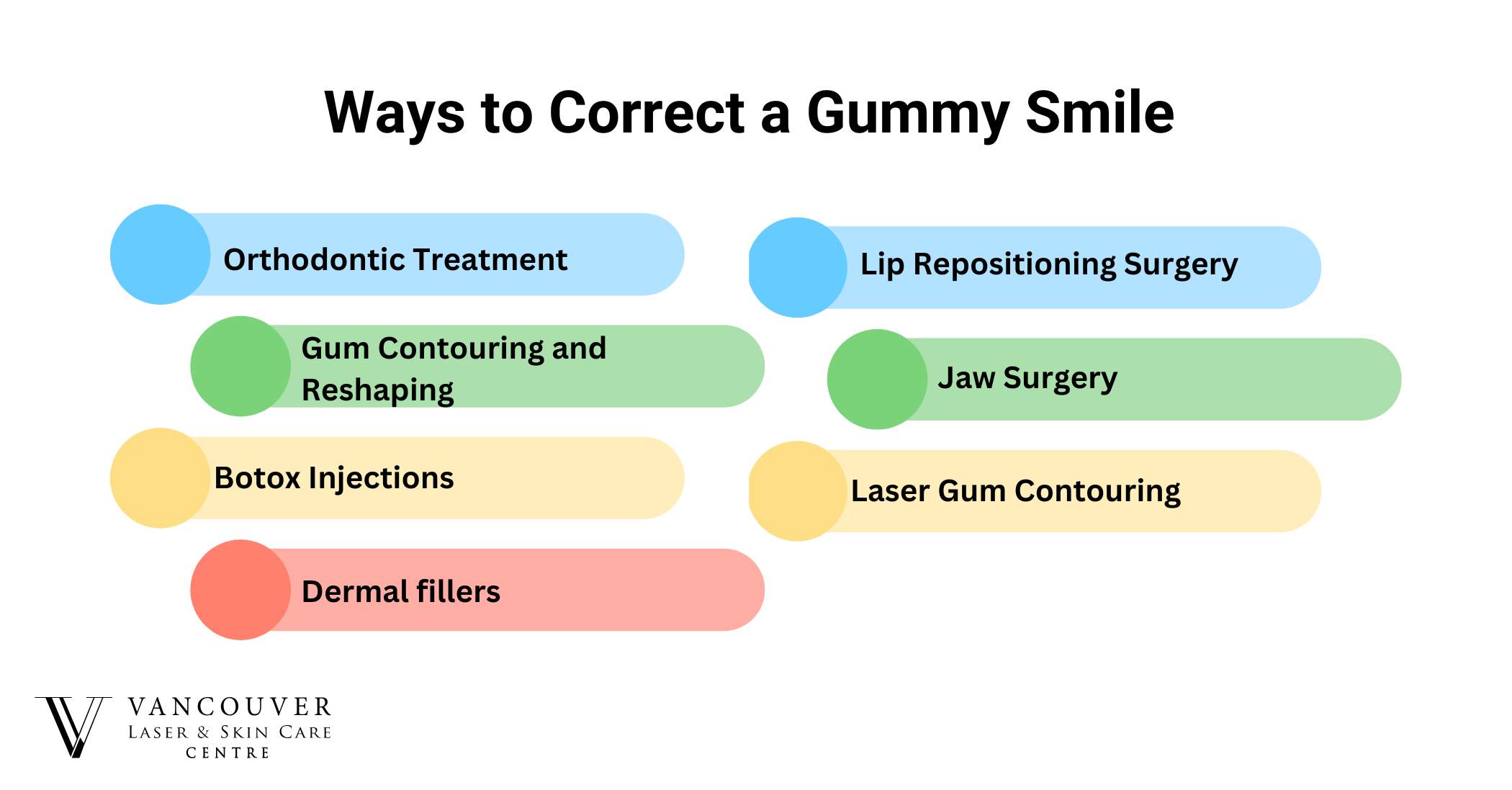A gummy smile, where excessive gum tissue is visible when smiling, can impact both appearance and confidence. This common dental concern can arise from various factors, including excessive gum tissue, jaw alignment, or even muscle movement.
Fortunately, there are a variety of effective treatments available, ranging from non-invasive options like Botox and dermal fillers to more advanced surgical solutions.
In this post, we’ll delve into the causes of a gummy smile, explore natural remedies that may help manage its appearance, and discuss both surgical and non-surgical treatment options.
Additionally, we’ll cover whether a gummy smile changes with age and provide answers to frequently asked questions to guide you in making informed decisions.
Can a gummy smile be corrected?
Yes, a gummy smile can be corrected through various treatments. Depending on the cause, options include non-invasive solutions like Botox injections or dermal fillers and surgical procedures such as gingivectomy or lip repositioning. Orthodontic treatments and cosmetic options like veneers or crowns can also improve your smile’s appearance.
A consultation with a specialist is essential to determine the best treatment for a balanced, confident smile. At Vancouver Laser & Skin Care Centre, our experienced team provides personalized consultations to identify the ideal solution for your needs. Contact us today to start your journey toward a beautiful smile.
Treatment Options for a Gummy Smile
Several effective treatments can correct a gummy smile, tailored to its underlying cause. Here are some common solutions for achieving a balanced and aesthetically pleasing smile:

Orthodontic Treatment
Improper tooth alignment or bite issues can contribute to a gummy smile. Braces or clear aligners reposition teeth and adjust the bite, reducing excess gum tissue visibility.
Gum Contouring and Reshaping
Gum contouring and reshaping reduce excess gum tissue to enhance your smile. Depending on the correction needed, it may involve gum removal alone or with bone adjustment. Two common procedures are:
- Gingivectomy: This surgical procedure removes excess gum tissue to reveal more of the teeth. It can be performed with a scalpel or laser for precision and minimal discomfort.
- Crown Lengthening: Involves removing gum tissue and possibly a small amount of bone to create a balanced gum-to-tooth ratio.
Botox Injections
A hyperactive upper lip can cause excessive gum exposure, making Botox injections an effective solution. Botox relaxes the upper lip muscles, preventing it from rising too high when smiling. This treatment typically requires 2-10 units of Botox, depending on the individual’s needs. At Vancouver Laser & Skin Care Centre, this service falls within our minimum spend of $200 with the doctors, which includes up to 16 units.
While Botox provides excellent results, it is not a permanent solution. Due to the frequent use of facial muscles, treatments need to be repeated every 3-4 months to maintain the desired appearance. This quick and non-invasive option is ideal for those seeking temporary improvements without surgery.

Dermal Fillers
Dermal fillers add volume to the upper lip, enhancing lip fullness and creating a more balanced smile. However, fillers alone do not significantly reduce gum visibility. For optimal results, a lip flip with neuromodulators, such as Botox, is often paired with dermal fillers. This combination relaxes the upper lip muscles while enhancing volume, effectively reducing gum visibility and maintaining a natural appearance. This quick, non-surgical solution provides a harmonious improvement to your smile.
Lip Repositioning Surgery
This minimally invasive procedure repositions the upper lip to limit its upward movement. Small incisions inside the lip allow it to be reattached at a lower position on the gums, reducing gum exposure.
Jaw Surgery
For severe cases caused by vertical maxillary excess (overgrowth of the upper jaw), orthognathic surgery repositions the upper jaw to reduce gum visibility. This is a more invasive procedure for significant corrections.
Laser Gum Contouring
Laser technology offers a precise and minimally invasive option to reshape the gum line. It effectively reduces excess gum tissue, creating a more symmetrical and attractive smile.
Can you fix a gummy smile naturally?
Fixing a gummy smile naturally is challenging, as it often involves structural issues requiring professional treatment. However, some natural methods may help reduce its appearance:
- Facial Exercises: Strengthening the muscles around your mouth through exercises, such as smiling with closed lips or lifting your upper lip slightly, can improve muscle control.
- Lip Exercises: Gently stretching your upper lip downward over your teeth and holding for a few seconds may help adjust lip positioning over time.
While these methods may offer minor improvements, they are unlikely to significantly address gummy smiles caused by underlying structural issues. For more effective and lasting results, consult a professional at Vancouver Laser & Skin Care Centre. Our experts can recommend the best treatment options for gummy smiles.
Does a gummy smile reduce with age?
A gummy smile typically does not reduce with age. It is often caused by excessive gum tissue, a short upper lip, or dental issues, none of which naturally change over time.
While facial structure and muscle tone may slightly alter your smile’s appearance as you age, these changes are neither predictable nor significant.
What causes a gummy smile?
Understanding the causes of a gummy smile is essential for determining the best treatment. Here are the most common reasons a gummy smile occurs:

Excess Gum Tissue
Some individuals naturally have more gum tissue covering their teeth. This can make teeth appear shorter and gums more prominent when smiling.
High Lip Line
A hyperactive or high upper lip exposes more gum tissue when smiling. This happens when the muscles controlling the upper lip pull it higher than usual.
Teeth Development
Improper eruption of teeth or naturally shorter teeth can leave more gum tissue exposed, contributing to a gummy smile.
Jaw Growth
Overgrowth of the upper jaw, known as vertical maxillary excess, causes the gums to extend further down, resulting in a gummy appearance.
Gingival Hyperplasia
Overgrowth of gum tissue, often due to inflammation, certain medications, or hormonal changes, can lead to a gummy smile.
Conclusion
A gummy smile can affect your confidence, but understanding its causes and exploring effective treatments can help you achieve a balanced and radiant smile.
Whether your gummy smile is due to excess gum tissue, jaw growth, or a hyperactive upper lip, there are numerous options available—from non-invasive solutions like Botox and dermal fillers to advanced surgical treatments like gum contouring or jaw surgery.
At Vancouver Laser & Skin Care Centre, we specialize in personalized treatments tailored to your needs. Our experienced team is here to guide you every step of the way, ensuring you receive the best care and results. Don’t let a gummy smile hold you back—schedule a consultation with us today and take the first step toward a confident, beautiful smile.
FAQs
1. What causes a gummy smile?
A gummy smile results from factors like excessive gum tissue, a short or overactive upper lip, tooth development issues, or upper jaw positioning.
2. Can a gummy smile be corrected?
Yes, various treatments can correct a gummy smile, including orthodontics, cosmetic dentistry, Botox, or surgical options.
3. Are there non-surgical treatments for a gummy smile?
Yes, non-surgical options like Botox relax the upper lip muscles, temporarily reducing gum visibility when smiling.
4. How long does it take to recover from gummy smile surgery?
Recovery from procedures like crown lengthening or lip repositioning usually takes one to two weeks.
5. How long does it take to correct a gummy smile?
The time varies by treatment. Botox and fillers show immediate results, while orthodontics may take months to years.



